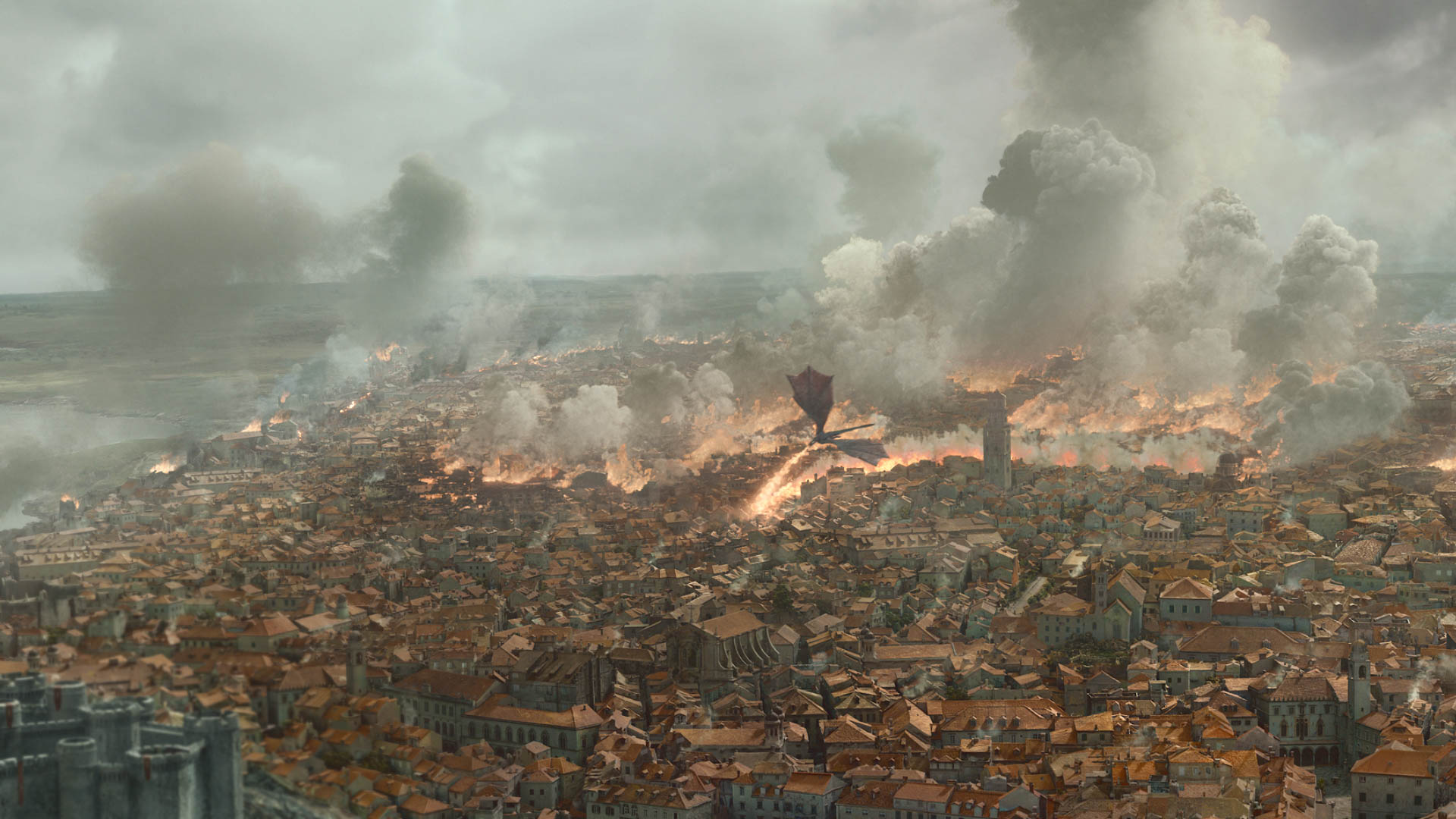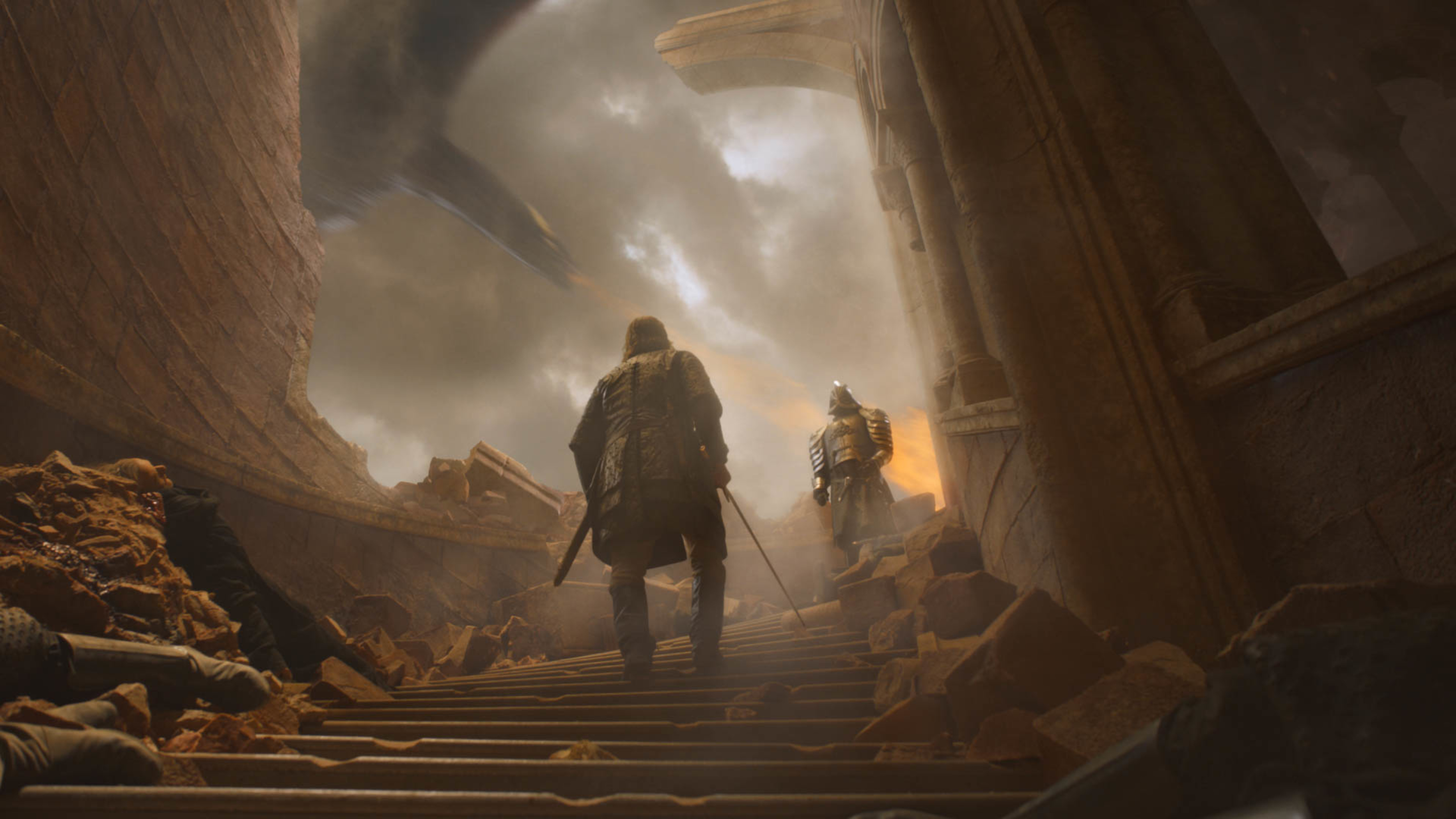HBO’s mega franchise aims to end on a high note with its seventh consecutive VFX Emmy with more destructive firepower than ever before.

The horrific sight of Dany (Emilia Clarke) turning into the Mad Queen in Season 8 of “Game of Thrones” and vaporizing King’s Landing atop Drogon became the ultimate expression of destruction for the series. Indeed, the “Battle of King’s Landing” from Episode 5 (“The Bells”) dwarfed all previous annihilation, with the VFX stepping up by taking its cue from London after the Blitz and the fire bombing of Dresden toward the end of World War II.
King’s Landing finally comes crashing down during the firebombing, the Clegane brothers (Rory McCann and Hafþór Júlíus Björnsson) perish from their battle, and the Red Keep castle collapses on Cersei (Lena Headey) and Jaime (Nikolaj Coster-Waldau). “So, after seven years of building out the physical and sometimes emotional world of ‘Thrones’ through use of visual effects, in ‘The Bells,’ it was time to add an exclamation point,” said Joe Bauer, the lead VFX supervisor. “Our brains registered a level of shock when reading the script pages. Now our world building methods would be used to un-build, to de-construct.”
King’s Landing was based on Dubrovnik in Croatia and the massive set build was created by the team of production designer Deborah Riley. “Interestingly, we had never before been required to so thoroughly create the Westerosi city, nor had any practical set been built with such immense complexity,” said Bauer, “nothing short of capturing in 3D scans nearly all of Old Town Dubrovnik would suffice as a starting point.”

“Game of Thrones”
HBO
The particle work alone was of a scale never before attempted for TV. “Unleashing the full, almost Godzilla-like force of Drogon on a rampage was a thrill,” Bauer said, “but what it meant weighed heavily on us: Dany would never again represent hope for a better world. Finally she could not escape her own blood line. Heavy stuff. The city had to be leveled, and we had a single dragon to execute the carnage. And that took some backward engineering.”
Director Miguel Sapochnik started with a small previs team in LA (The Third Floor) and then rolled it over in Belfast with a larger team, concentrating mostly on Arya’s (Maisie Williams) run through the city, and trying to work out all the practical gags that had to inform the set build. “As far as Dany and Drogon, that previs and techvis was worked out with The Third Floor team in Belfast,” Bauer said. “They came up with the shots that made the most sense.
“She’s wiping out particular streets and then she heads for the Red Keep…and also the tower where the ‘Clegane Bowl’ happened [the crew’s term for the brothers’ battle]. And Sam Conway, who’s the special effects lead, was able to lay out 180 feet of practical pyro, so we figured out where that should go and placed six or seven cameras on that so we could use that same explosion for a number of streets in the sequence. Most of the blast was motion control or scaled practical fire.”

“Game of Thrones”
HBO
Scanline VFX served as the lead VFX studio for “The Bells,” including full digital environment, Dany’s attack on the long-range artillery weapons (Scorpions), city gate and the streets, the destruction of Red Keep, and the battle between the brothers. “We developed a semi-automatic process of converting high-res photogrammetry scans of Dubrovnik, delivered from Joe Bauer and Steve Kullback [the VFX producer], into managed, optimized assets compatible with our modeling, texturing and destruction pipeline,” said Mohsen Mousavi, Scanline’s VFX supervisor.
“At its core, King’s Landing was based on modular building assets similar to Lego building blocks,” added Mousavi. “We took the technology we developed years ago for the creation of the digital San Francisco in the film ‘San Andreas’ and pushed it to the next level for Season 8. We were able to build many intact and damaged assets, which were efficient enough to sync with the Dubrovnik style of architecture, but at the same time, were engineered carefully to work in our simulation pipeline.”
Image Engine, meanwhile, delivered the dragon animation and Scanline did the final look development, rendering and compositing of the dragon into the shots. “Very early on, we received a dragon lookdev package, which included different generations of what was established over the years as well as animation caches and final composite of some key shots from Season 7 as reference to match,” Mousavi said. “We spent a great deal of time analyzing the look and rebuilt the shaders from scratch.”

“Game of Thrones”
HBO
In terms of destruction, Scanline received the Red Keep assets from the previous seasons as a base and redesigned the entire courtyard and the main plaza in front of the castle. “We needed to rework most of the assets to make it technically sound for various destruction scenarios,” said Mousavi. “We started very early on using the blocking animation, which gave us a clear indication of the timing and the layout of when and where the dragon fire would hit. This was represented consistently with a cone across all our back and forth with Joe and Image Engine through the whole process. The tricky part was to make the fire extremely forceful but staying away from the wrecking ball look.
“We represented the fire as an extreme passive force, which instantly push everything out of the way and vaporized to fire and ashes,” Mousavi said. “For the scene when the dragon blows up the King’s Landing gate, the production built a third scale miniature of the gate and blew it up, but, unfortunately, it did not have a big enough fireball to tell the story. It was shot from five different angles, it looked great, but they wanted more of a fiery event. So they gave us the challenge to almost recreate that digitally. It turned out as one of the most immensely complex digital pyro-shots of the series. We came up with one simulation that could be used in all the angles consistently similar to the original idea of the third scale miniature.”
The most important constant was Bauer’s desire to provide a photographic sensibility to the VFX, going for an accurate, doc-like style and staying away from overly dramatized compositions. “Making it all seem real was a tall task, and an honor to finally achieve [on this scale],” he said.
Game of Thrones – Season 8: Breakdowns from ScanlineVFX on Vimeo.
Sign Up: Stay on top of the latest breaking film and TV news! Sign up for our Email Newsletters here.




















![[Book Review] The Blade Itself (The First Law Trilogy) by Joe Abercrombie](https://bendthekneegot.com/wp-content/uploads/2018/01/1516047103_maxresdefault-218x150.jpg)

















